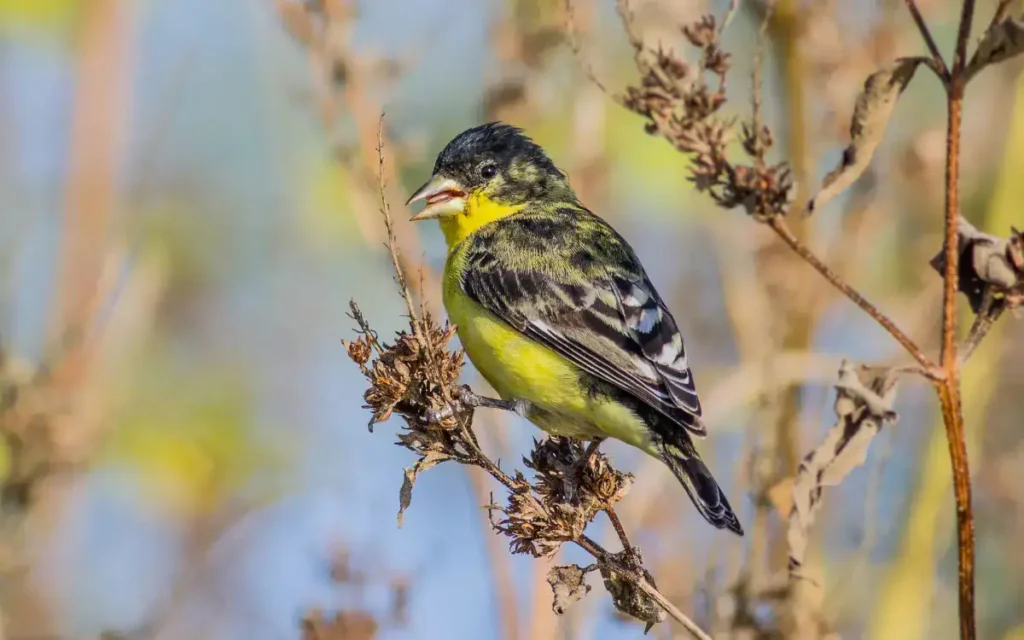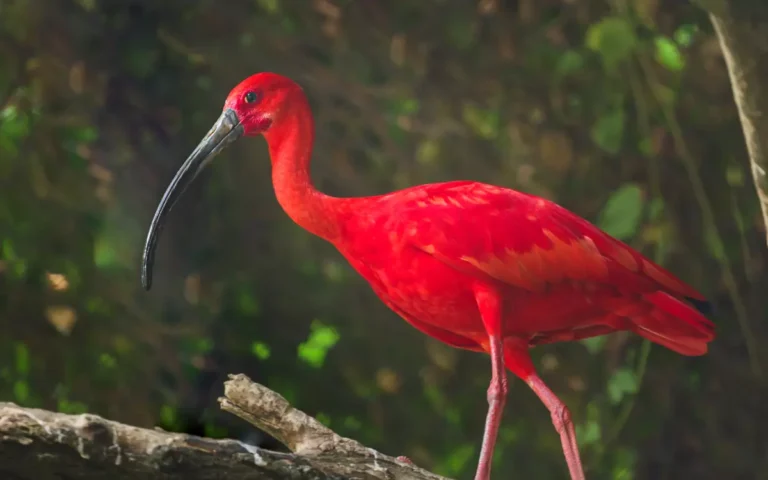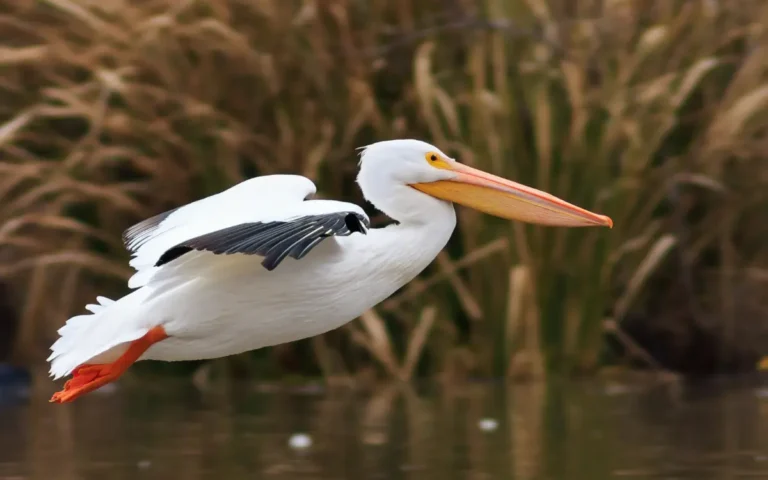10 Finches in Florida with Photo

Welcome to our magical Finches in Florida! These charming birds add color and melody to Florida’s various ecosystems, attracting bird watchers and nature enthusiasts similarly.
10 species of finches in Florida
1. House Finch:

- Kingdom: Animalia
- Phylum: Chordata
- Class: Aves
- Order: Passeriformes
- Family: Fringillidae
- Genus: Haemorhous
- Species: Haemorhous mexicanus
The House Finch is a small bird easily spotted by the bright red plumage of males. These birds are a common sight in urban areas and backyards across Florida, making them familiar to many residents.
They have a simple diet, primarily enjoying seeds, with sunflower seeds being a particular favorite . Their presence in everyday settings makes them excellent subjects for beginning birdwatchers to learn about bird behavior and feeding habits.
- Length: 5.1 – 5.5 in (13 – 14 cm)
- Weight: 0.6 – 0.9 oz (16 – 27 gm)
- Wingspan: 7.9 – 9.8 in (20 – 25 cm)
2. American Goldfinch:

- Kingdom: Animalia
- Phylum: Chordata
- Class: Aves
- Order: Passeriformes
- Family: Fringillidae
- Genus: Spinus
- Species: S. tristis
The American Goldfinch is notable for its striking appearance. Males display a vibrant yellow color in spring, which fades to a duller shade in winter. These birds adapt well to various environments and are commonly found in Florida’s gardens and woodlands.
Known for their social nature, American Goldfinches typically travel in flocks and are frequent visitors at bird feeders . Their colorful presence and lively behavior make them a delight for bird enthusiasts and casual observers alike.
- Length: 4.3 – 5.1 in (11 – 13 cm)
- Weight: 0.4 – 0.7 oz (11 – 20 gm)
- Wingspan: 7.5 – 8.7 in (19 – 22 cm)
3. Purple Finch:

- Kingdom: Animalia
- Phylum: Chordata
- Class: Aves
- Order: Passeriformes
- Family: Fringillidae
- Genus: Carpodacus
- Species: Carpodacus purpureus
The Purple Finch is a vibrant bird, with males showcasing a rose-red color rather than yellow during spring. Their plumage dulls somewhat in winter. These finches are found in various habitats throughout Florida, including both gardens and woodlands.
Known for their gregarious nature, Purple Finches often travel in flocks and are regular visitors at bird feeders, particularly during the cooler months . Their striking appearance and social behavior make them popular among both casual observers and avid birdwatchers.
- Length: 4.7- 6.3 in (12 – 16 cm)
- Weight: 0.6 – 1.1 oz (18 – 32 gm)
- Wingspan: 8.7 – 10.2 in (22 – 26 cm)
4. Pine Siskin:

- Kingdom: Animalia
- Phylum: Chordata
- Class: Aves
- Order: Passeriformes
- Family: Fringillidae
- Genus: Spinus
- Species: Spinus pinus
The Pine Siskin is a small finch recognizable by the vibrant yellow highlights in its plumage, especially visible in males during spring. This coloration becomes duller in winter. Pine Siskins are adaptable and can be found in a variety of habitats across Florida, including gardens and woodlands.
They are known for their social behavior, often traveling in flocks, and are commonly seen at bird feeders. These traits make them interesting and accessible birds for beginner birdwatchers and nature enthusiasts.
- Length: 4.3 – 5.5 in (11 – 14 cm)
- Weight: 0.4 – 0.6 oz (12 – 18 gm)
- Wingspan: 7.1 – 8.7 in (18 – 22 cm)
5. Indigo Bunting:

- Kingdom: Animalia
- Phylum: Chordata
- Class: Aves
- Order: Passeriformes
- Family: Cardinalidae
- Genus: Passerina
- Species: P. cyanea
The Indigo Bunting is renowned for its striking blue coloration in males, particularly vibrant during the breeding season. These small birds adapt well to various environments and are commonly found in Florida’s woodlands and farmlands.
Indigo Buntings are known for their solitary behavior, but during migration, they may travel in small groups. They are frequent visitors at bird feeders where they are often seen perched on high vantage points like telephone wires or tree tops. Their brilliant blue plumage and distinctive singing make them a favorite among birdwatchers.
- Length: 4.7 – 5.1 in (12 – 13 cm)
- Weight: 0.4 – 0.6 oz (12 – 18 gm)
- Wingspan: 7.5 – 8.7 in (19-22 cm)
Related article:
- 11 Types of Red Birds in Florida
- 11 Types species of Geese In Florida: (ID &Images)
- 36 Species of Warblers In Florida: Length, Weight ,Wingspan
- 14 White Birds in Florida: Exploring Their (ID & PICS)
6. Evening Grosbeak:

- Kingdom: Animalia
- Phylum: Chordata
- Class: Aves
- Order: Passeriformes
- Family: Fringillidae
- Genus: Hesperiphona
- Species: H. vespertina
The Evening Grosbeak is a striking bird, with males featuring a vibrant yellow and black coloration during spring. Their colors become somewhat duller in winter. These robust finches are occasionally spotted across various habitats in Florida, including gardens and woodlands.
Known for their social nature, Evening Grosbeaks often travel in flocks and are drawn to bird feeders where they can be observed feeding on a variety of seeds. Their distinctive appearance and behavior make them a fascinating subject for birdwatchers and nature enthusiasts.
- Length: 6.3 – 7.1 in (16 – 18 cm)
- Weight: 1.9 – 2.6 oz (53 – 74 gm)
- Wingspan: 11.8 – 14.2 in (30 – 36 cm)
7. Lesser Goldfinch:

- Lesser Goldfinch:
- Kingdom: Animalia
- Phylum: Chordata
- Class: Aves
- Order: Passeriformes
- Family: Fringillidae
- Genus: Spinus
- Species: S. psaltria
The Lesser Goldfinch is distinguished by the bright yellow on the males, more vivid during the breeding season, and duller in winter. These small finches are found in a variety of habitats across Florida, including gardens and woodlands.
Known for their sociable nature, Lesser Goldfinches often travel in flocks and are commonly seen at bird feeders, enjoying a diet mainly of seeds. Their striking coloration and lively flock dynamics make them a delightful sight for birdwatchers and nature lovers.
- Length: 3.5 – 4.3 in (9 – 11 cm)
- Weight: 0.3 – 0.4 oz (8 -11.5 gm)
- Wingspan: 5.9 – 7.9 in (15 – 20 cm)
8. Yellow-fronted Canary:

- Kingdom: Animalia
- Phylum: Chordata
- Class: Aves
- Order: Passeriformes
- Family: Fringillidae
- Genus: Crithagra
- Species: C. mozambica
The Yellow-fronted Canary stands out with males showcasing vibrant yellow feathers during spring, which become more subdued in winter. These small, lively birds adapt to a range of environments and are frequently seen in Florida’s gardens and woodlands.
They typically travel in flocks and are common visitors at bird feeders, where they enjoy a diet of seeds . Their bright plumage and sociable nature make them a joy to watch, adding a splash of color and activity to any birdwatcher’s day.
- Length: around 4.5 in (11.4 cm)
- Weight: 0.3 – 0.6 oz (8.5 – 16.2 gm)
- Wingspan: 7.9 – 9.8 in (20 – 25 cm)
9. Common Redpoll:

- Kingdom: Animalia
- Phylum: Chordata
- Class: Aves
- Order: Passeriformes
- Family: Fringillidae
- Genus: Acanthis
- Species: A. flammea
The Common Redpoll is a small finch known for its reddish forehead and black chin, easily spotted during the colder months. These birds adapt well to cold climates and are seen in varied habitats, including Florida’s woodlands and gardens during migration.
Common Redpolls travel in flocks and are frequent visitors at bird feeders, especially attracted to thistle seeds .Their resilience to cold and charming appearance, coupled with their social nature, make them intriguing birds for watchers and enthusiasts.
- Length: 4.7 – 5.5 in (12 – 14 cm)
- Weight: 0.4 – 0.7 oz (11 – 20 grams)
- Wingspan: 7.5 – 8.7 in (19 – 22 cm)
10. Red Crossbill:

- Kingdom: Animalia
- Phylum: Chordata
- Class: Aves
- Order: Passeriformes
- Family: Fringillidae
- Genus: Loxia
- Species: Loxia curvirostra
The Red Crossbill is notable for its unique beak, which crosses at the tips, designed specifically for extracting seeds from conifer cones. This adaptation makes them especially fascinating. They are found in various habitats across Florida, particularly in forested areas where conifers are present.
Red Crossbills are known for their nomadic behavior, often moving in flocks in search of food sources. They are less commonly seen at typical bird feeders unless those feeders offer their preferred seeds . Their distinctive feeding behavior and unusual beak shape make them a captivating subject for birdwatchers.
- Length: 5.5 – 6.5 in (14 – 16.5 cm)
- Weight: 0.7 – 1.4 oz (20 – 40 gm)
- Wingspan: Around 10.5 in (27 cm)
Know more about – List of all finch species
Finch Watching Tips:
The best locations in Florida for finch-watching include bird sanctuaries and natural parks such as Everglades National Park and the Florida Keys. These spots are great for seeing various finches.
To attract finches to backyard feeders, use sunflower seeds or nyjer seeds. These seeds are favorites among finches. Place the feeder in a quiet area to keep birds safe while they eat.
Conservation status and habitat protection are crucial because many finch species depend on specific habitats that are threatened by development. Protecting these areas helps maintain the biodiversity of our planet.
Some FAQs:
Q: Do finch birds live in Florida?
Ans: Yes, several species of finch birds, including the House Finch, Purple Finch, American Goldfinch, and Pine Siskin, live in Florida.
Q: Does Florida have yellow finches?
Ans: Florida does have finches that may appear yellow, such as the American Goldfinch, especially during the breeding season when males display bright yellow plumage.
Q: Do goldfinches migrate to Florida?
Ans: American Goldfinches, known for their vibrant yellow color in the breeding season, do migrate to Florida, particularly in the winter months.
Conclusion:
Finch birds, including vibrant yellow finches like the American Goldfinch, are indeed present in Florida. Some, like the American Goldfinch, migrate to Florida, especially during winter, adding to the state’s avian diversity.






